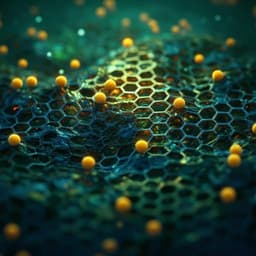
Engineering and Technology
A bioinspired analogous nerve towards artificial intelligence
X. Liao, W. Song, et al.
Discover the groundbreaking APT nerve, an all-in-one bionic artificial nerve that mimics biological neural networks! Developed by a team of researchers including Xinqin Liao and Weitao Song from Nanyang Technological University, this innovative technology showcases rapid response, high durability, and zero energy consumption, making it a potential game-changer for human-machine interfaces and neuroprosthetics.
~3 min • Beginner • English
Introduction
The study addresses key challenges in artificial sensory neural systems: complex integration of discrete sensing, recognition, and transmission units; intricate interconnections and circuitry; potential interference in signal transmission; the need for low or no standby power; and mechanical compliance comparable to biological nerves. The authors propose an all-in-one artificial perception and transmission (APT) nerve that unifies mechanosensation, spatial recognition of stimulus location, and signal transmission within a single, flexible device. Inspired by biological sensory neurons and axonal transmission, the APT nerve aims to convert external mechanical stimuli directly into electrical signals with spatiotemporal differentiation, enabling neuromorphic-like processing without pixelated sensor arrays. The work is positioned to facilitate neuroprosthetics and intelligent robotics by providing a robust, low-power, flexible, and easily configurable tactile interface capable of spatiotemporal coding and multifunctional human–machine interactions.
Literature Review
The paper situates its approach within advances in bionic sensors and neuromorphic systems: highly sensitive tactile sensors (e.g., giant magneto-impedance materials for low-pressure detection), ionic cables for high-speed long-distance signal transmission mimicking axons, and laterally coupled indium–zinc–oxide artificial spiking transistors for spatiotemporal processing. Despite these developments, most systems integrate discrete elements leading to complex wiring and potential signal interference. The authors argue for a unified architecture that minimizes interconnections, reduces complexity, and supports low/no standby power, mechanical softness, and compliance akin to biological nerves.
Methodology
Design and working principle:
- Architecture: An artificial perception and transmission (APT) nerve constructed as two opposing conductive graphite films drawn on paper substrates (graph paper) and assembled face-to-face with a spacer to form a separated electrical double-layer structure. The long-strip morphology enables combined sensing and transmission functions and can be reconfigured into various shapes (linear, I-shaped, S-shaped, L-shaped, square) for different applications.
- Operation: In the resting state the upper and bottom conductive layers are separated, eliminating current flow and standby energy consumption. Under local mechanical stimulation (e.g., finger touch), the layers make contact only at the stimulated location, creating an electrical path. The device operates via an electrical contact sensing mechanism.
- Equivalent circuit: The APT nerve is modeled as a series of resistor units (upper layer resistors Ru and bottom layer resistors Rh) separated by switches. A stimulus closes the local switch, yielding a response resistance R_res that depends on the path length from electrodes to the contact point. The total resistance increases with distance from the electrodes, enabling location recognition. An illustrative relation: R_total = Σ R_i (Ru + Rh + … + Rh + Ri), showing monotonic increase with stimulus location distance.
- Bending compensation: Because bending induces opposite resistance changes in the two layers, the overall resistance remains relatively stable, allowing operation under bending.
Fabrication (from Methods):
- Substrate/patterning: Two pieces of adhesive tape (Scotch Magic TAPE 810) are placed on graph paper (No.7034, CAIANCAL) to define a hollow area (typically 5 × 18 mm²). An 8B graphite pencil (No. 6841, Deli) is used to fill the hollow area to form conductive graphite films/lines serving as active layers/paths. Pattern designs create regulated, discontinuous conductive lines.
- Assembly: Adhesive tapes are applied along the sides to define and maintain a spacer gap (typical spacer thickness ≈ 0.12 mm) ensuring separation at rest. Two patterned paper-based parts are fabricated as mirror images and then joined face-to-face with the spacer to complete the APT nerve. The design is compatible with various geometries (linear, L, square, etc.). Final tape encapsulation isolates the paper from moisture, imparting waterproofness.
Signal acquisition and driver circuit:
- A linear amplification stage converts resistance to voltage using an op-amp with gain Vout = (1 + R_feedback / Rg) × Vref. The output is digitized by a microcontroller board (Arduino Leonardo with ATmega32u4), using its 10-bit ADC (0–1023) at ~10 Hz sampling.
- A lookup table maps digital voltages to stimulus locations (segments) to generate predefined commands via USB to a PC. The system tolerates small contact-area variations without additional denoising or baseline drift correction. On stimulus removal, the voltage returns rapidly to baseline.
Characterization and measurements:
- Resistance range: For an active layer of 5 × 14 mm² and spacer thickness 0.12 mm, measured response resistances ranged from ~0.5 kΩ (near electrodes) up to ~15 kΩ (farthest point), with an approximately linear relation vs. location.
- Tools: Scanning electron microscopy (JEOL JMS 6360A) for surface observation; multimeters (UNI-T UT389A, 34641A) for electrical parameters; Keithley 2450 for applied potentials; calibrated loading using load cells.
Spatiotemporal coding and applications:
- The APT nerve is virtually segmented (non-pixelated) to create multiple perception regions along its length or across 2D layouts. Demonstrations include: musical note triggering (Do–Si) on a linear strip; 2D cursor/chess piece positioning using an L-shaped device (X1–X7, Y1–Y7); and rotation control of an earth model using a square device with perception zones (A1–A4).
- Spatiotemporal inputs (e.g., touches at different locations separated by time intervals) produce distinct amplitude-time patterns enabling basic spatiotemporally dynamic logic, analogous to multiple presynaptic inputs to interneurons.
Environmental robustness:
- Tape encapsulation confers waterproofness for operation with sweaty fingers and preserves performance in humid environments. The device can remain functional after partial cutting because only the segment between electrodes and touch point determines R_res.
Machine learning concept (perceptual learning):
- A framework is outlined where mechanosensitive signals are captured, features extracted (e.g., location L, hold time H, inter-touch interval I over 10 s), and fed to a neural network for decision-making, demonstrating compatibility with AI-based classification of touch patterns.
Key Findings
- Unified sensing-transmission device: A single APT nerve converts local mechanical touch into electrical signals and recognizes stimulus location without pixelated arrays or complex interconnects, with no power consumption at rest.
- Linear location encoding: Response resistance increases approximately linearly with distance from electrodes across spacer thicknesses and active layer widths/lengths. Width scaling changes absolute resistance but preserves linearity; spacer thickness influences contact completeness.
- Performance metrics: Rapid response time <21 ms to touch; durable and repeatable operation for ≥10,000 cycles; operational stability under bending due to opposing resistance changes in the two layers; waterproofness and retention of functionality after partial cutting of the device.
- Sensitivity/threshold: Detectable response threshold around ~5 kPa; tests commonly used ≈10 kPa to ensure above-threshold loading.
- Resistance span and mapping: For a representative device (active 5 × 14 mm²; spacer 0.12 mm), response resistance spans ~0.5 kΩ (near electrodes) to ~15 kΩ (farthest), enabling robust voltage mapping via the driver circuit (10-bit ADC, ~10 Hz sampling).
- Spatiotemporal dynamic logic: Distinct amplitude-time responses to touches at different positions and intervals (e.g., 3 cm vs. 6 cm at 2.7 s spacing) emulate spatiotemporal integration seen in neural networks.
- Multifunctional demonstrations: (i) Musical scale triggering (Do–Si) with a 140 mm linear strip divided into seven segments; (ii) 2D positioning on a 7 × 7 grid using an L-shaped device with X1–X7 and Y1–Y7 segments; (iii) Rotation control of a model using a flexible square APT nerve (zones A1–A4). These tasks required no additional denoising or baseline tracking.
- Fabrication simplicity and adaptability: Pencil-drawn graphite on paper with adhesive spacers enables low-cost, flexible, reconfigurable devices in varied geometries.
Discussion
The APT nerve addresses the core challenge of integrating mechanosensation, spatial recognition, and signal transmission without the complexity of multi-sensor arrays and associated wiring. By using a separated electrical double-layer architecture with contact-based sensing, the device exhibits linear location-dependent resistance changes, enabling straightforward decoding of touch position via simple amplification and ADC mapping. The rapid responses, robustness to bending and partial damage, waterproof operation, and durability over >10,000 cycles demonstrate suitability for stable human–machine interactions. The spatiotemporal differentiation of signals mirrors basic neural network logic, supporting perceptual learning tasks and AI-based classification without elaborate preprocessing. Collectively, these properties support applications in neuroprosthetics (restoring touch perception and providing intuitive control) and intelligent robotics (interactive, low-power tactile interfaces) while simplifying circuit design and reducing fabrication complexity.
Conclusion
This work presents an all-in-one, flexible APT nerve that unifies mechanosensation, location recognition, and signal transmission, operating with no standby energy consumption and requiring minimal circuitry. It enables non-pixelated, virtually segmented sensing with rapid response, high robustness, waterproofness, and durability, validated through multifunctional demonstrations (music playing, 2D positioning, and rotation control) and basic spatiotemporal logic emulation. The simple, scalable fabrication (graphite-on-paper with adhesive spacers) and compatibility with machine learning pipelines position the APT nerve as a practical building block for advanced neuroprosthetics and socially intelligent robotics. Future directions include material diversification to achieve stretchability and transparency, further integration with AI for enhanced spatiotemporal pattern recognition, and large-scale manufacturing of customized device geometries for application-specific tactile interfaces.
Limitations
- Detection threshold: The device requires mechanical stimuli above ~5 kPa to generate stable responses; sub-threshold stimuli are not detected.
- Contact dependence: Increased spacer thickness can lead to incomplete layer contact, slightly increasing response resistance and potentially affecting sensitivity.
- Protective encapsulation trade-offs: While additional protective protocols could further extend durability, the authors note these may lengthen preparation, require more materials, increase costs, and reduce portability.
- Material constraints: Current prototypes use paper-based substrates and graphite films; while flexible, they are not inherently stretchable or transparent (envisioned as future work).
Related Publications
Explore these studies to deepen your understanding of the subject.







